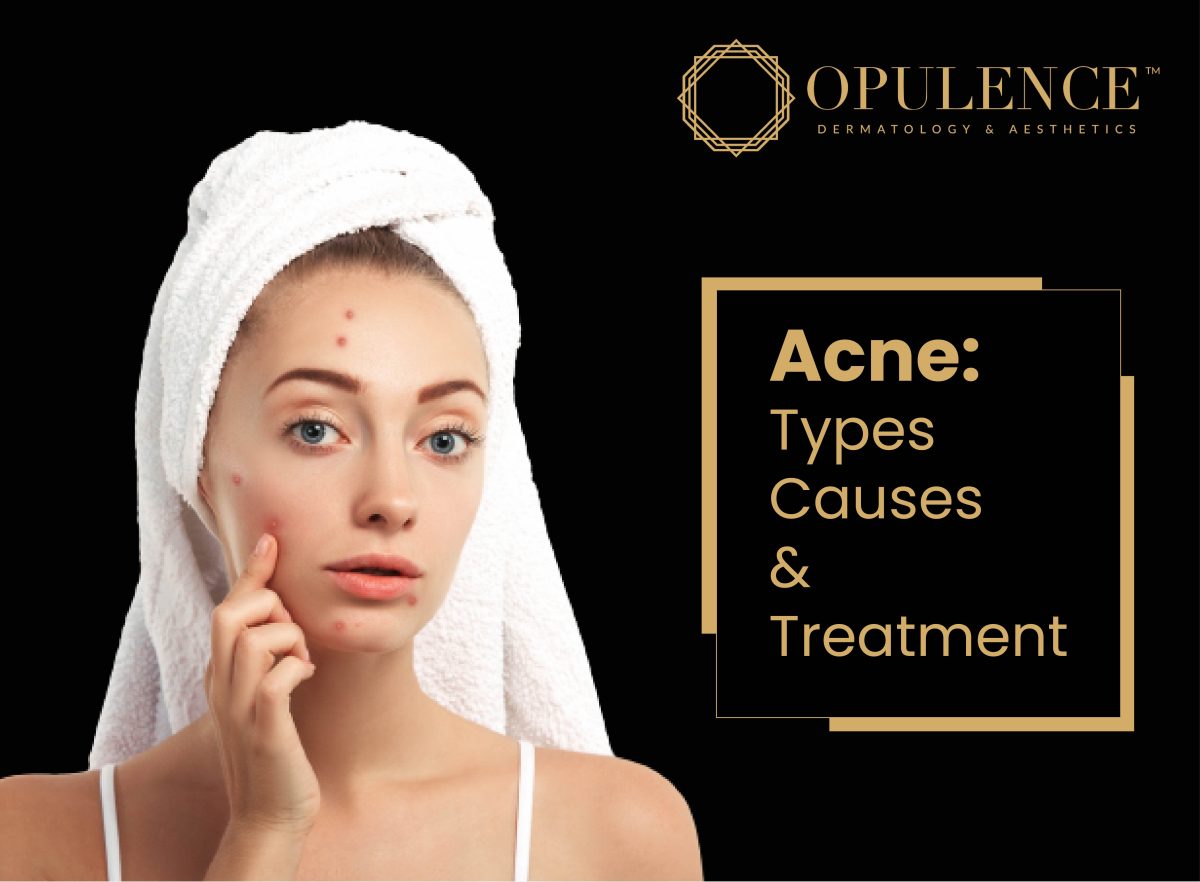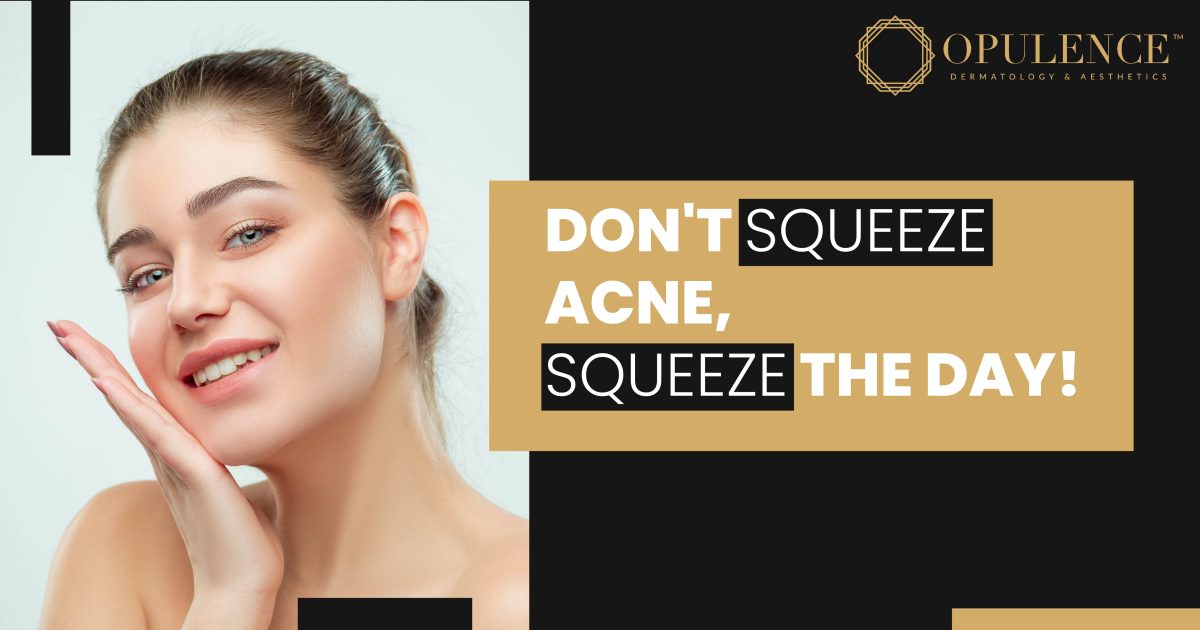ACNE SCARS. TYPES. TREATMENT

Bumpy, bright red acne can lead to a lot of emotional distress.
Teenagers face bullying which can cause them to not like themselves.
Acne is a very common skin condition.
Yet, it just makes going to school or college difficult for them.
Where they wish the acne on their face magically disappears as they wake up every morning.
But acne is stubborn too, it won’t go away that easily.
Opulence Dermatology & Aesthetics, a skin treatment clinic in Ahmedabad will help you fight this stubborn acne.
And, if you’re looking for acne treatment, you’ve stumbled upon the right page!
A negative body image of yourself can be quite frustrating, isn’t it?
It might even interfere with your studies and events.
It is upon you to take control of your skin.
But first, let’s get to know acne before defeating it!
Table of Contents
- What is Acne?
- Types of Acne
- Causes of Acne
- Acne Treatments
- A Word from Opulence Dermatology & Aesthetics…
What is Acne?
Acne is a pretty common skin problem characterized by blocked hair follicles beneath the skin.
Sebum (oil that keeps skin from drying out) and dead skin cells clog pores, causing pimples or zits to appear.
This is also why oily skin has more chances of getting acne.
The eruptions mostly affect the face, although they can also affect the back, chest, and shoulders.
You’re not alone if you suffer from acne.
It’s the most frequent skin problem that people have.
Acne affects 80% of people between the ages of 11 and 30.
But wonder why teenagers suffer the most from acne?
A spike in androgens (particularly testosterone) is one of the causes of acne.
These are produced by both women and men.
Those hormones are at their highest during adolescence.
We will elaborate on that for you later on in this blog.
The majority of us experience it at some point in our lives.
The face, forehead, chest, shoulders, and upper back are the most typical areas where acne can appear.
Oil glands (sebaceous glands) can be found all over your body, but they are concentrated in those areas.
The best technique to treat acne is determined by its severity.
It can be mild, moderate, or severe, depending on its type.
Types of Acne
Acne can arise in a variety of ways which depends on size, color, or pain.
- Blackheads
Plugged follicles that reach the skin’s surface and open.They seem black on the skin’s surface because the sebum (oil secreted by sebaceous glands) is discolored by the air, not because they are filled with dirt.
- Whiteheads
A white bump is caused by blocked hair follicles that remain beneath the oily and dead skin. - Cysts
Pimples that are filled with pus and are deep and painful. These have the potential to leave scars. - Nodules
Solid pimples that pierce your skin deeply. They’re big and hurt a lot. - Fungal Acne
When an excess of yeast forms in the hair follicles, this fungal acne develops. They can become irritated and itchy.This is also known as pityrosporum folliculitis.
- Papules
Inflamed pimples that show on the skin as little pink lumps and are painful to the touch. - Pustules
Papules with white or yellow pus-filled lesions at the top and crimson at the bottom.
The earlier you visit a dermatologist, the better.
Next is to determine what caused your acne.
It can be difficult to treat acne without knowing its cause.
Let’s that a look at them.
Causes of Acne
Acne is primarily a hormonal disorder triggered by androgen hormones, which peak in activity between adolescence and early adulthood.
It is caused by sensitivity to these hormones, which can be exacerbated by surface germs on the skin and fatty acids in the oil glands.
There are certain things that could trigger androgen hormones and could’ve caused your acne breakout:
- Sugary foods
- Acne sores being picked at.
- Genetics
- Pollution and certain weather conditions, particularly high humidity.
- Acne flare-ups can be exacerbated by stress,
- which raises the level of the hormone cortisol.
- Medications
- Dandruff
- Head accessories and headgears
A skin specialist can examine it accurately and help you manage acne so you don’t have to undergo the pain and stress it brings.
And that is why you also need to be aware of what you are going through.
Which helps you deal with it better.
To deal with it, you need to start preventing it.
Here are some tips to prevent acne:
- Wash your face twice a day.
- Understand your skin type. Is it oily, dry, a combination of both, or sensitive?
- Use fragrance-free and non-comedogenic moisturizer to hydrate your skin.
- Use over-the-counter treatments that have benzoyl peroxide or salicylic acid.
- Avoid touching your face frequently.
- Limit your exposure to the sun.
- Don’t pop the pimple, if you are doing it, do it the right way. It can cause you scars.
- Avoid sugary items.
- Try managing your stress, and if it is severe, get professional help.
There are a few myths about acne and its prevention.
Opulence Dermatology & Aesthetics will help you stay away from these and help you fight acne with facts.
The prevention tips mentioned above might help you manage your acne on time but sometimes things go out of hand.
Some breakouts can’t be controlled without sufficient medical attention and care from a dermatologist.
Acne Treatments
There are various factors to keep in mind when a dermatologist prescribes you an acne treatment.
Several drugs and treatments have been shown to be beneficial.
They are designed to address the underlying causes of acne.
Depending on the severity of your ailment, you may need at least one or many.
Topical Treatments
- Benzoyl peroxide is available as a leave-on gel or wash over-the-counter.
It targets germs on the skin’s surface, which can worsen acne.
- Salicylic acid is available over-the-counter as a cleanser or lotion.
It aids in the removal of the damaged skin’s top layer and removes dead skin cells, preventing blockage of hair follicles.
- Retinoids aid to avoid clogged pores, which are the initial indicators of acne, by breaking up blackheads and whiteheads.
It is a not-spot treatment; it must be applied to the entire affected area of the skin to prevent new pimples from forming.
Appropriate for most of the patients.
- Antibiotics manage the germs on the surface of the skin that irritates and often increase acne swelling.
When antibiotics are coupled with benzoyl peroxide, they are more effective.
- Azelaic acid is a natural acid that can be found in grains like barley, wheat, and rye.
It lowers the swelling and kills bacteria on the skin.
Oral Medications
- Antibiotics, same as topical antibiotics, these reduce inflammation and clear the microorganisms on the skin.
- Contraceptives can aid in the treatment of breakouts caused by menstrual cycles.
But first, don’t forget to consult a dermatologist, so then it does not go wrong.
Medical Procedures
- Lasers
Laser treatments come in a variety of forms.
The optimal type for you is determined by several factors, including your skin tone and color, as well as your ultimate aim.
A high-intensity beam of light is focused onto the skin during laser therapy.
A laser can reduce swelling and acne-causing germs, aid in the healing of existing pimples, and stimulate the skin to regenerate itself, based on the treatment utilized.
Acne and acne scars are treated with lasers.
Some lasers only require one treatment, while others require many treatments. - Chemical Peels
Chemical peels involve the removal of the top layer of skin to improve the condition of the skin.
These peels exfoliate softly and require no downtime, however, your skin may seem pink afterward.
For mild acne, superficial peels are the best option.
There are different types of chemical peels and
Your skin may flake or “peel” off over the next few days to weeks, revealing the rejuvenated skin underneath.
Chemical peels, like laser treatments, can be used to treat acne and scarring.
A Word from Opulence Dermatology & Aesthetics…
Acne has been stigmatized in our society a lot which can leave a person in distress.
It is normal to have acne and don’t let anyone tell you otherwise.
It is an uncomfortable condition but there are effective treatments that exist to help you get rid of them.
Acne therapy should be started as soon as possible to manage them and avoid acne scarring.
Acne scars can be hard on your mind because they stay for life.
If you’ve already developed acne scars, a dermatologist can provide additional advice on how to reduce the look of scarring.
It is always the game of time while tending to acne.
The earlier you take a step to treat it, the clearer your skin will be tomorrow.
Acne-free skin might seem like a distant dream, but it is closer than you believe.
So, are you ready to get acne-free skin? Get in touch with us today!










